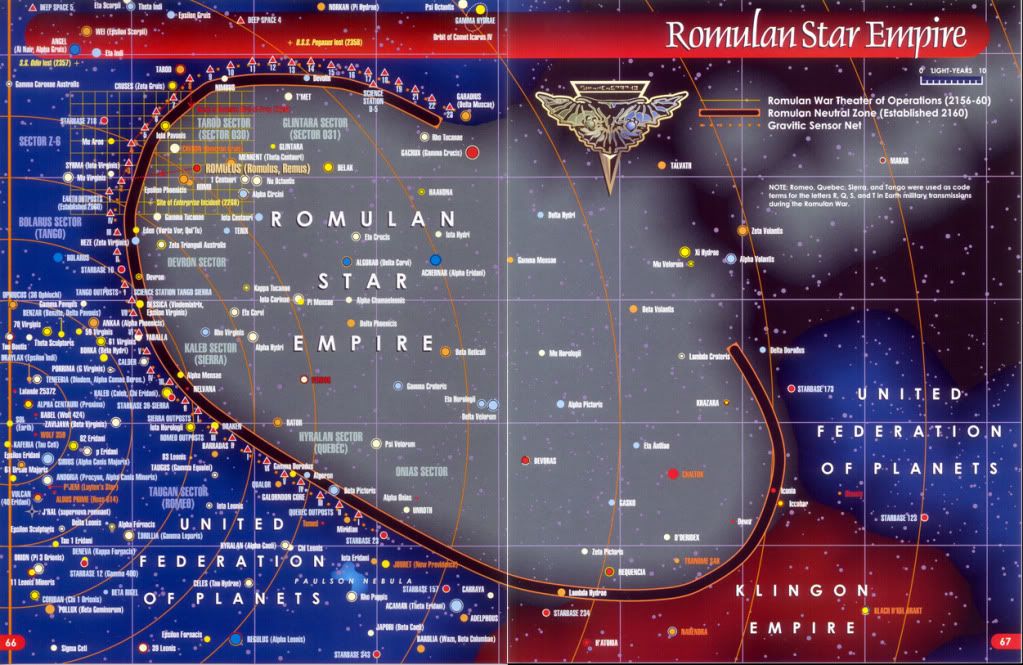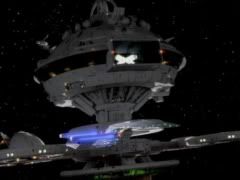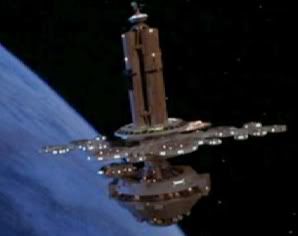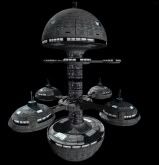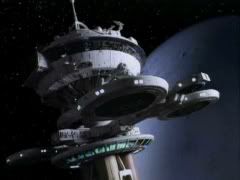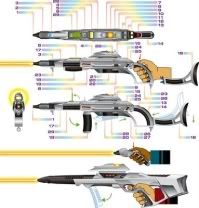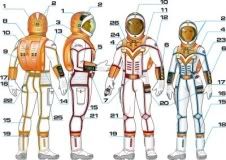Space Combat Maneuvers
Manuevers
During combat, starships act by performing manuevers. The manuevers follow a standard format.
Name of Manuever
Prerequistites: This would list the skill and what skill level is needed to perform the manuever.
Special: Either the manuever that must be successfully executed prior to evecuting the manuevers, or restrictions on when the manuever can be employed. For example, before a ship can use Target Subsystem, it must first have successfully executed a Lock On manuever, while the Full Stop Manuever can not be performed immediately after a Fast Attack Manuever. If a manuever requires that you do multiple manuevers first, you must fo these manuevers in the order listed. For instance to execute a Cochrane Deceleration manuever, for instance, you must first Come About, then Match Speed, then execute a Cochrane Deceleration. Restrictions only apply to the previous manuever, either in the current round or from the round before. If you perform an Evasive Attack as the last manuever in one round, you can not Fire as your first manuever in the second round, although you could execute another manuever then Fire.
Duration: May manuevers have a duration of "instant." The Manuever is performed, takes effect immediately, then ends.
Difficulty: This would list the base skill difficulty number for the skill test.
Effect: The maneuver's effects on combat between Starships.
Listing of Manuevers
Antimatter Pod Detonation
A desperate starship equipped by antimatter pods and offline weapon systems can try to eject a pod and detonate it, like a torpedo.
Prerequisite: Starship Tactics (Starfleet) 3
Special: This requires Lock On and Point Blank or Short Range. Starship weapon systems must be damaged or offline.
Duration: Instant
Target Number: 7
Effect: If the Manuever succeeds, the pod does 40 points of damage to the enemy. If the pod was detonated at Point Blank range, the acting ship suffers 20 points of splash damage.
Chain Collisions
The ship fires at its target, hoping to send it on a collision course with one of its allies, or at least hoping that good-sized hull fragments will collide with the other ship.
Prerequisite: Shipboard Systems (Tactical) 3
Special: Cannot be used after Evasive Attack or Full Attack. Requires Shields to be down on opposing ship.
Duration: Instant
Target Number: 7
Effect: If the Manuever is a complete success, both ships suffer damage as per a minor collision. In the case of a dramatic success, a major collison happens.
Close
The Starship closes the distance between it and an opposing vessel, often to bring its weapons into more effective range.
Prerequisite: Shipboard Systems (Flight Ops) 1
Special: This cannot be used after Evasive Attack, Fast Attack, or Picard Maneuver.
Duration: Instant
Target Number: 4
Effect: Decreases range by 1 increment for a success, 2 increments for a dramatic success. You may choose to decrease range by less than the increment indicated by the skill test result.
Cochrane Deceleration
An extremely fast and difficult stop, the Cochrance Deceleration forces an ipposing ship to fly past the starship using this maneuver.
Prerequisite: Starship Tactics (Starfleet) 3
Special: The ship must have revently done a Come About and Match Speed manuever this round or in the previous round.
Duration: Special
Target Number: 7
Effect: The acting ship must successfully Come About and Match Speed before attempting this maneuver. When successfully performed, the acting starship gains a +2 bonus from attacks made by the primary target for the remainder of the round. In addition, the tactical officer may immediately perfrom one tactical manuever in excess of the ship's action for the current round at no penalty. The tactical officer must still make the appropriate skill test. Cochrane Deceleration automatically increases the distance between the acting ship and its primary target by one range increment (from short to medium, for example) and brings the ship to a Full Stop (as per the maneuver).
Come About
The starship performs a quick turn to avoid an incoming attack.
Prerequisite: Shipboard Systems (Flight Ops) 1
Special: None
Duration: Instant
Target Number: 4
Effect: Come About allows a ship executing this maneuver to break an opponent's target lock. If the primary target does not have Lock On, then add +2 to the opponent's difficulty to attain it this round. The maneuver only affects the acting ship's primary target, and only affects one opposing ship per use.
Combine Fire
Several starships combine their fire on their primary target, under the lead of the acting ship, in an attempt to penetrate the shields more efficiently.
Prerequisite: Starship Tactics (Starfleet) 3
Special: Lock On is required.
Duration: Instant
Target Number: 7 + 2 per ally combining fire
Effect: The target number of this maneuver is 7 +2 per ally combining fire. If successful, the acting ship gets an immediate tactical maneuver to attack the primary target. It gets a damage bonus equal to 125% of the weapon being used to combine fire. In the case of a dramatic success the damage bonus is equal to 150% of its standard damage.
Concentrate Fire
The Starship closes the distance between it and an opposing vessel, often to bring its weapons into more effective range.
Prerequisite: Shipboard Systems (Tactical) 3
Special: This cannot be used after Evasive Attack or Fast Attack.
Duration: Instant
Target Number: 7
Effect: When applying this maneuver, choose one weapon system, such as phasers, disrupters, or photon torpedoes. For each missle launcher or beam bank available of the given weapon, the tactical officer can choose to apply a -2 penalty to the skill test made to attack, for a bonus of 25% to the weapons damage up to a maximum of 200%.
Disengage
The Helm disengages from battle entirely, either prepatory to warping away or to change targets in the middle of combat.
Prerequisite: Shipboard Systems (Flight Ops) 3
Special: None
Duration: Instant
Target Number: 7 +2 per opponent currently engaged.
Effect: Before executing the manuever, you must declare whether you are leaving the battlefield or changing primary targets. Withdrawing has a skill test of 7 plus 2 per opponent currently engaged in the battle. This test represents the helmsman's ability to steer a course clear of opposing ships. Failure could indicate that another opponent blocked the ship, or that the helmsman of the primary target vessel maintains a close distance. If changing primary targets, no skill test is necessary. The new target now becomes your primary target until you disengage again, or the target is destroyed. In either case, the manuever leaves your ship vulnerable to attack. Your ship suffers a +2 to your opponent's tactical rolls until your next helm manuever.
Dodge
The acting ship chooses a vector, begins its movement, but before completing it, changes direction completely in a dodging feint versus one ship.
Prerequisite: Shipboard Systems (Flight Ops) 3
Special: Can not be used after Full Stop
Duration: Instant
Target Number: 7
Effect: Choose a ship, if the manuever succeeds, the acting ship gains a +4 difficulty to the opponent's tactical roll to hit the acting ship. If the roll is a dramatic success, the acting ship gains a +6 roll to the opponent's tactical roll to hit the acting ship. If the roll is a faillure, the opposing ship gains a +4 bonus to hit the acting ship. If the roll is a dramatic failure, the opposing ship gains a +6 bonus to hit the acting ship.
Evasion
The ship performs a series of sharp turns and dodges to shake off attackers.
Prerequisite: Shipboard Systems (Flight Ops) 3
Special: None
Duration: Instant
Target Number: 7 +2 per opponent currently engaged.
Effect: For each attacker, the ship wants to shake off, the helmsman adds +2 to the difficulty roll of his System Operations (Helm) test. The dodged ships lose Lock On. Those that didn't have Lock on add a +4 penalty to the difficulty of their tactical skill test to attack the ship the next time they act.
This manuever is similiar to Minimal Aspect, Come About, and Hard About in that it allows the breaking of an attacker's lock. However, there is no modification to the range (as in Hard About), and it works against a number of attackers, unlike Hard About and Come About. It is harder to perform than Minimal Aspect, that also works against a number of attackers, but it makes the ship harderer to attack as well.
Evasive Attack
The starship performs an unexpected evasive manuever while attacking at the same time.
Prerequisite: Starship Tactics (Starfleet) 5
Special: Come About or Hard About, must Close.
Duration: Special
Target Number: 10.
Effect: This maneuver allows the acting starship to increase range to the primary target by +1 range increment, grants a +5 bonus to the next helm manuever executed, and the tactical officer may perform a free Fire manuever. The helm manuever bonus lasts until the target's next action. Thus if the target takes an action after Evasive Attack, but before the acting starship executes its Helm Manuever, the +10 bonus is lost.
Exploit Weakness
The acting ship looks for a minute flaw in the its primary target's defensive systems, from a momentary weakness in the shields to a fluctuation in the power grid.
Prerequisite: Shipboard Systems (Tactical) 5
Special: Lock On, a succeeded sensor test analyzing the ship's status, which is used only to look for the weakness.
Duration: Instant
Target Number: 10.
Effect: Before using this maneuver, the acting ship must have successfully analyzed its target's status. The weakness is used as a "piece of information" given about the target vessel - i.e. a success allows the sensor officer to find about the weakness and nothing else, a Dramatic Success gives away the weakness and another piece of information.
Then, the ship can use the maneuver, the ship fires one of its weapon systems at the target, just like the Fire Maneuver. However for the duration of the maneuver the damage threshold of the target's shields is reduced by 25%, in the case of a Dramatic Success the target's shields damage threshold is reduced by 50%.
As an additional effect, it is possible to try to beam personnell aboard the enemy ship by exploiting the weakness, if this manuever is a success. This then requires a System Operations (Transporter) test at a 10 target number. In the case of a failure, the beam-out fails and may be attempted only at the next succeeded execution of this maneuver. For a Dramatic Failure, all characters transported suffer a mix-rematerialization. A number of personnel up to the number of personnel transporters may be transported in this manner.
A new sensor test analyzing the target's status must be rolled for wach new execution of this manuever - the defensive array weakness is always erased by the ship's attack, as power is redistributed to sustain the impact, making a new scan necessary to find another "blind spot".
Fast Attack
The starship rapidly closes the distanct to an opponent and speeds past him, firing weapons throughout the strafing run.
Prerequisite: Starship Tactics (Starfleet) 5
Special: Must Close by two range increments in one maneuver.
Duration: Instant
Target Number: 10.
Effect: If successful, the maneuver allows the acting ship a free Multi-weapon maneuver and increases the range to the primary opponent by 2. The tactical officer must make an attack skill test as normal (see Multi-weapon). This manuever does not occur a multiple action penalty for the one Multi-weapon maneuver. The attacking ship must have closed the distance to the defending ship by two range increments with one maneuver, either in the current, or the previous, round.
Feint
The acting starship behaves as it was attacking its target in a particular manner, but changes its attack vector at the last moment, creating an effect of suprise and increasing the impact of its weapon fire.
Prerequisite: Shipboard Systems (Tactical) 3
Special: Cannot be used after Evasive Attack, Fast Attack, or Z-Axis.
Duration: Instant
Target Number: 7
Effect: When applying this maneuver, choose a weapons array such as torpedos or phasers. The acting ship may choose to make itself more open to attack, in order to increase the efffect of the weapons penetration. On a success, the acting ship gives the defending ship a +2 bonus to hit it with its next maneuver, but reduces the defending ships shields by 10% for this attack only. In the case of a Dramatic Success while using this maneuver, the shields will be reduces by 25% for this attack only.
Fire
The basic attack command, the starship fires either its beam weapons, photon torpedos, or other weapons.
Prerequisite: Shipboard Systems (Tactical) 1
Special: Cannot be used after Evasive Attack, Fast Attack, or Z-Axis.
Duration: Instant
Target Number: 4
Effect: The starship fires one weapon system at its primary target.
Fire in Passing
The acting ship takes the opportunity to fire on a ship at range, that is not its primary target, as it passes near.
Prerequisite: Shipboard Systems (Tactical) 3
Special: Targeted ship at medium range or closer.
Duration: Instant
Target Number: 7
Effect: Make an attack roll on a ship that is not the primary target, and that is at medium range or closer. Apply one weapon effect normally, as per the fire manuever.
Forge Readings
Using the Navigational Deflector as an emitter for a certain type of energy, a ship can try to fool its enemies' sensors. It can try to create an echo of itself, or a shadow of its warp signature, for example, creating the illusion that there are two ships instead of one.
Prerequisite: Starship Tactics (Starfleet) 1
Special: Starship with a functional Navigational Deflector
Duration: Instant
Target Number: 4
Effect: If the maneuver succeeds, the ship's engineer must take an Systems Engineering test at a target number of 10 to create an illusion. If the test succeeds, roll 1d6 for each enemy ship intending to take the acting ship as primary target. On an odd result, the acting ship is indeed taken as primary target; on an even result the image is taken. If the test is a dramatic failure, the Navigational Deflector burns out.
The illusion lasts for a certain time, determined by the test result of the manuever roll: one round for a Success, three rounds for a Dramatic Success. However, if any enemy ship succeeds at a Tactical Maneuver against the illusion, the trick is revealed and all effects lost. Enemy ships having taken the image as primary target may choose freely another primary target at he beginning of the following round.
This maneuver may only be used once in combat.
Full Attack
The starship lays down a withering hail of fire, attacking with every available weapon at a multitude of targets.
Prerequisite: Starship Tactics (Starfleet) 5
Special: Lock On, Match Speed, must be at Point Blank or Short range.
Duration: Instant
Target Number: 10
Effect: This is an extremely difficult maneuver to perform. The acting ship must currently have Lock On and Match Speed, as well as be in the Point Blank or Short range increment. If successful, the tactical officer may perform both the Multi-fire and Multi-weapon maneuvers with no multiple action penalty. The officer declares the order in which ships are attacked, starting with the primary target, and declares which weapon systems are being used. A failed attack test does not halt the chain of attacks.
Full Stop
The starship comes to a full stop, making it essentially an immobile weapons platform. The ship sacrifices mobility, and increases the likelihood of being attacked, for an improved chance to successfully attack.
Prerequisite: System Operations (Flight Ops) 1
Special: Cannot be used after Fast Attack.
Duration: Until another Helm maneuver is performed.
Target Number: 4
Effect: This manuever grats a +2 bonus to System Operations (Tactical) skill tests, but also grants opponents a +2 bonus to their tactical tests.
Hard About
A steeper turn than Come About, the starship makes a sudden turn to improve its position or to avoid attacks.
Prerequisite: Shipboard Systems (Flight Ops) 3
Special: None
Duration: Instant
Target Number: 7
Effect: This maneuver produces the same effects as Come About with the added value of allowing you to increase or decrease the range to your primary target, as your ship uses its sharp turn to improve its position. A ship executing this maneuver to break an opponent's Lock On. If the primary target does not have Lock On, then add a +4 difficulty to the target's tests to gain Lock On. This maneuver only affects the acting ship's primary target; opponents that nominate the acting ship are not affected. Thus, Hard About only affects one opposing ship per use.
Head On Approach
The acting ship approaches its primary target straight-on, then moves out of the way at the last moment in order to pass behind. This is a risky strategy since both ships pass very near one another.
Prerequisite: Shipboard Systems (Flight Ops) 3
Special: Cannot be used after Immelman Turn.
Duration: Instant
Target Number: 7
Effect: If the maneuver is successful, the acting ship finds itself at Point Blank range of its target, and gains a +2 bonus to tactical maneuvers against its primary target until next round. If it fails, both ships suffer Full Collision damage.
Immelmann Turn
An Immelmann Turn is a sharp, sustained turn that results in the hunter becoming the hunter.
Prerequisite: Starship Tactics (Starfleet) 3
Special: Close, Hard About.
Duration: Special
Target Number: 7
Effect: This Maneuver affects opponents by making it more difficult to perform Helm or Tactical maneuvers. With a successful test, all opponents with the acting ship as their primary target suffer a -4 penalty if their next action is a Helm or Tactical maneuver. In addition, ships performing this maneuver automatically close with their primary target by one range increment (no test required).
Intercede
The acting ship tries to interpose itself between an attacked ship and its attacker, in order to protect it by drawing enemy fire.
Prerequisite: Shipboard Systems (Flight Ops) 3
Special: Can not be used after an Evasive Attack, Full Attack; object to protect of equal size or smaller than the acting ship.
Duration: Special
Target Number: 7
Effect: If this maneuver is a success, the acting ship interposes itself in between the attacking ship and the one the acting ship is trying to defend. One ship attacking the protected ship can not fire beam weapons at its target and suffers a +3 penalty to the test when firing warheads. The attacker also can not reduce the range seperating it from its primary target for as long as the maneuver lasts. These effects remain as long as the range between the attacker and the acting ship does not change, or when the acting ship decides to break intercession. In any case, the attacking ship can freely choose to abandon its primary targer and choose the ship that interposed itself as the new primary target.
Land
This maneuver allows ships with atmospheric capability to land on planets, starbases' landing pads, asteroids ...
Prerequisite: Shipboard Systems (Flight Ops) 1
Special: Ship in Low Atmosphere planet of any class other than J or T, or ship at Point Blank range of its mother ship. Match Speed if mother ship is moving.
Duration: Instant
Target Number: 4
Effect: To have a character perform this maneuver, the Narrator might weant to add some penalties due to the condition, such as visiblity or the stability of landing ground. If the maneuver is successful, the ship manages to land. In the event of a failure, the approach maneuver fails, and the Helm officer has to try again; in the case of a Dramatic Failure, the ship crashes more than it lands, and suffers damage equal to double its size. Crash damage is halved if the shuttle tries to land in a shuttlebay with emergency forcefields raised.
Lock On
The tactical officer locks weapons onto a opposing ship, concentrating the ship's fire against a single opponent. The ship's targeting computers give attack priority to the affected opposing ship, making attacks against other vessels more difficult.
Prerequisite: Shipboard Systems (Tactical) 1
Special: None
Duration: Lasts until broken by another maneuver.
Target Number: 4
Effect: Establishing Lock On with a target increases the effectiveness of your weapon systems and allows you to execute more complex attack commands. Once Lock On has been achieved, it lasts until broken by an opposing ship's maneuver, and until then affects all attack test made by the attacking ship. Lock On provides a +1 bonus to skill tests made to attack the target ship.
Match Speed
The starship matches its speed relative to that of its primary target. This not only enables other, more sophisticated maneuvers, it makes the target easier to hit.
Prerequisite: Shipboard Systems (Flight Ops) 3
Special: Cannot be used after a Z-Axis.
Duration: Lasts while range is maintained.
Target Number: 7
Effect: With a successful skill test, the starship matches speed with its primary target. While the two ships maintain the same relative distance - both ships remain at the same range increment they were at when Match Speed was executed - the starship performing this maneuver gains a +2 bonus to System Operations (Tactical) tests made to attack. For example, the Ascendant is at short range from a Romulan Warbird when it performs a Match Speed maneuver; so long as the two ships remain at short range, the Ascendant gains a +2 bonus to attack tests. This often the first maneuver executed in a round on the ship's initiative.
Maximum Coverage
The ship orients itself toward its primary target so as to maximize the impact of its weapon arrays.
Prerequisite: Shipboard Systems (Flight Ops) 1
Special: None.
Duration: Instant
Target Number: 4
Effect: If the maneuver is successful, the overall damage of the ship's next tactical maneuver is increased by 10%. In the case of a Dramatic Success, the overall damage is increased by 25%. If the acting ship does not perfrom a tactical maneuver just after Maximum Coverage, then the effects are lost.
Multi-Fire
The starship fires one weapons system at multiple ships, regardless of its primary target.
Prerequisite:Shipboard Systems (Tactical) 3
Special: All targets must be in the same range increment.
Duration: Instant
Target Number: 7 + 1 for each opponent fired at.
Effect: Choose one weapon system affected by this maneuver - such as beam weapons or torpedoes. The starship fires this system at multiple targets. The tactical officer declares which ships he's targeting and the order of attack before he makes his first roll (though the primary target must be attacked first). Roll one attack test for each target, suffering a cumulative +1 test difficulty for each target fired at after the first. For example, firing at the primary target has no Multi-Fire penalty, but firing on the secondary target incurs the +1 test difficulty making the difficulty on average an 8. A failed attack does not halt the chain of attacks, each weapon's damage is figured seperately.
Multi-Weapon
The starship fires two or more weapon systems (phasers and photon torpedos, for example) at one opponent.
Prerequisite: Shipboard Systems (Tactical) 3
Special: Lock On
Duration: Instant
Target Number: 7
Effect: With a successful skill test to attack, the primary target suffers damage from each weapon system employed. The damage is combined and compared to the target vessel's shields. Damage that exceeds the target's shields is then applied against the ship's hull rating and then to the ship itself.
Open
The starship opens the distance between it and an opposing vessel, ofetn to make attacks by the opposing ship less effective or to leave the battlefield entirely.
Prerequisite: Shipboard Systems (Flight Ops) 1
Special: None.
Duration: Instant
Target Number: 4
Effect: Successfully executing this maneuver increases range by 1 increment for a success and two increments for a Dramatic Success. You may choose to increase the range by less than the increment indicated by the test result (only opening the range by 1 increment if two are indicated). Ships that move beyond extended have left combat range, and are considered to have fled the battle (though a new battle may be initiated if the opposing ships pursue).
Photonic Pulse
Focusing an intense emission of photons in its main deflector dish, a ship can release a high-energy pulse that can blind enemy sensors.
Prerequisite: Starship Tactics (Starfleet) 3
Special: Point Blank or Short range; ship with a functional navigational deflector.
Duration: One to three rounds.
Target Number: 7
Effect: If the maneuver succeeds, the ship's engineer must take a Systems Engineering test at target number 10 to charge the deflector. If the test succeeds, the primary target's sensors are knocked offline for a certain time, determined by the test result of the maneuver roll. One round for a success and three rounds for a Dramatic Success. If the engineering test is a Dramatic Failure, the acting ship suffers the effects of the pulse for two rounds, and the navigational deflector burns out.
Picard Maneuver
Made Famous by its inventor, Captain Jean-Luc Picard, this maneuver is especially difficult to perform. The starship takes advantage of relavistic time dilation by using a short warp speed burst to appear in two places at once, then fire on its opponent.
Prerequisite: Starship Tactics (Starfleet) 5
Special: Close, Lock On.
Duration: Instant
Target Number: 12
Effect: The acting starship must first Close and achieve Lock On to prepare for time dilation and the offensive action. Upon performing this maneuver, the acting starship generates an after image that results in a +5 penalty to the opposing ship's tactical maneuvers for this round. In addition, the tactical officer may perform one tactical maneuver at no multiple action penalty and make the appropriate skill test for the tactical maneuver.
Plasma Field
A ship can attempt to channel warp plasma through its navigational deflector, emitting it as a coherent energy beam to try and knock the enemy's propulsion system out of commision.
Prerequisite: Starship Tactics (Starfleet) 5
Special: Point Blank or Short range; starship equipped with a warp system and a functional navigational deflector.
Duration: Instant
Target Number: 10
Effect: If the maneuver succeeds, the ship's engineer must take an Systems Engineering (Navigational Deflector) test at a difficulty number of 7 to focus the beam. If the test succeeds, the primary target's propulsion system suffers damage and goes offline. If the Engineering test is a Dramatic Failure, the scting ship suffers the effect of the plasma field, and the navigational deflector is burned out.
Ramming Speed
In a last ditch effort to stop the enemy no matter the cost, the starship rams into the opposing vessel. Although this sacrifices both ship and crew, it usually destroys the opposing ship.
Prerequisite: Shipboard Systems (Flight Ops) 3
Special: Point Blank range, cannot be used at Full Stop.
Duration: Instant
Target Number: 7
Effect: The Helmsman makes a System Operation test against the target number. This reflects actually hitting the other ship. The target ship suffers a Major Collision, as well as the acting ship.
Random Fire
Where one doesn't know where the target is, for example if the ship is blind or the enemy is cloaked, a desperate way to fight is to shoot widly in all directions in a hope to hit something.
Prerequisite: Shipboard Systems (Tactical) 3
Special: None.
Duration: Instant
Target Number: 7
Effect: As this maneuver implies shooting blind, if the ship's sensors are offline, the usual -4 penalty is not applied for this maneuver. Only beam weapons can be used for Random Fire. If this maneuver succeeds, the acting ship actually hits the target. However, since the weapon has been fired in short pulses, it lacks real power. Only a third of the damage (rounded down) is applied. On a Dramatic Failure, the ship hits an ally.
Reassess Battle
The commanding officer takes some time to reassess the tactical situation of the battlefield, hoping to see a way to gain an advantage.
Prerequisite: Starship Tactics (Starfleet) 3
Special: None.
Duration: Until Initiative changes
Target Number: Not applicable
Effect: The acting starship makes a new initiative roll (reduced by -2 to account for the combat stress), and keeps this new score as if it was the one rolled at the beginning of combat. The new acting order takes place at the following round and onwards.
Shallow-Z
The maneuver is a variant of the Z-axis, easier to perform but with lesser advantages. The ship either dives or climbs following a shallow vector, taking advantage of the third dimension of space to orient itself.
Prerequisite: Shipboard Systems (Flight Ops) 1
Special: None.
Duration: Instant
Target Number: 4
Effect: If the maneuver is successful, the acting ship gains a +1 to the next maneuver, if its a Helm or Tactical maneuver. If a Command maneuver is executed after Shallow-Z, the effects are lost.
Shield Dimple
This technique implied firing a beam weapon at the opponent's shield to weaken them in one point, then firing immediately a warhead, hoping the shield will let it pass and that it will detonate directly against the enemy hull.
Prerequisite: Shipboard Systems (Tactical) 3
Special: None.
Duration: Instant
Target Number: 9
Effect: When attempting this maneuver, choose a beam weapon and a warhead weapon to be used. If the maneuver is a success, apply directly the warhead damage to the enemy's structure ignoring shields. People can be transported aboard the enemy ship in the short time, the window opens.
Shield Disruption
The ship reconfigures its navigational deflector to emit a beam of anti-protons, or an interferometric pulse, at very short range against its target. This may disrupt enemy shields.
Prerequisite: Starship Tactics (Starfleet) 3
Special: Starship only; functional navigational deflector; Point Blank range.
Duration: Instant
Target Number: 7
Effect: If the maneuver succeeds, have the ship's engineer roll a Systems Engineering rool at TN 10. If this succeeds, the tactical officer may perform a Fire maneuver for free - but no damage is applied, instead, if the Fire maneuver succeeds, the target's shield strength is reduced to 0. If the engineering test is a Dramatic Failure, the navigational deflector burns out.
Shield Repulsing
The acting ship reversed the polarity of its shields, then brushes its primary target's so as to push it through space, sending it tumbling out of the way. The acting ship may also manage to "bounce" on its target's shields, increasing the distance seperating both ships.
Prerequisite: Starship Tactics (Starfleet) 5
Special: Used by ships on ships only; Point Blank range, can not be used after a Full Stop, shield grid or similiar systems installed sbard the acting ship, must be used immediately after a succeeded System Operation (Shields) test.
Duration: Instant
Target Number: 10
Effect: Immediately before using this maneuver, the science officer must roll a successful Starship Operations (Shields) test to pinpoint and reverse the shield's polarity. Then if the maneuver succeeds, the target gains a +1 penalty to all Helm maneuvers for the next round, and the range between the ships is increased by 1. In the case of a Dramatic Success, the range is increased by 2. In case of a failure, the two ships suffer damage as per a Minor Collision; for a Dramatic Failure, a Major Collision happens.
Solar Flare
A ship can attempt to generate a solar flare by firing an electromagnetic pulse into the corona of a star. This is a very dangerous maneuver to perform - but very efficient.
Prerequisite: Starship Tactics (Starfleet) 5
Special: Acting ship is in the star's low atmosphere.
Duration: Instant
Target Number: 12
Effect: If the maneuver succeeds, a massive solar slare is generated, obliterating everything in its path (300 million kilometers in a straight line), from ship to station. If it results in a Dramatic Failure, the acting ship is obliterated as well.
Spread
The ship fires several weapons at once in a screen to increase the chances of hitting, but at the sacrifice of pinpoint accuracy.
Prerequisite: Shipboard Systems (Tactical) 1
Special: Can not be used after Evasive Attack, Fast Attack or Z-Axis.
Duration: Instant
Target Number: 4
Effect: When applying this meneuver, choose one weapon system, such as phasers, disruptors, or photon torpedoes. This maneuver grants a +1 to the skill test made to attack, for every 10% of damage the tactical officer is willing to deduct off the weapon's damage, up to a maximum of 30%.
Swoop
Like Z-Axis, the acting ship takes advantage of the third dimension of space, but the objective here is to gain a better aim: the acting ship swoops on its target, hoping to fire more easily.
Prerequisite: Shipboard Systems (Flight Ops) 3
Special: Can not be used after a Full Stop, Z-Axis or Immelmann Turn.
Duration: Instant
Target Number: 7
Effect: If the maneuver is a success, the acting ship gains a +2 bonus to its next tactical maneuver. The maneuver must take place just after Swoop, otherwise the effects are lost.
Take Cover
The acting ship tries to hide behind a large object and relatively static, such as a large asteroid, a planet or a starbase, in order to suffer less from enemy fire.
Prerequisite: Shipboard Systems (Flight Ops) 3
Special: Can not be used after Evasive Attack or Full Attack; object ot hide behind is at Point Blank range, bigger than the ship and bigger than a planet.
Duration: Until broken, or the range with cover changes.
Target Number: 7
Effect: If this maneuver is a success, one attacker can not fire beam weapons at the acting ship and suffers a +3 penalty to difficulty when firing warheads. The attacker can not reduce the range with the acting ship. These penalties are canceled as soon as the range between the attacker and the cover changes.
If the result is a Dramatic Failure, the acting ship is considered to have entered the phenomena, with no penalties to the attacker. If this is irrelevant (i.e. the ship attempted to hide behind an asteroid) then a Major Collision occurs. In any case, the chosen attacker can freely choose to abandon its primary target and choose the object that served as cover as the new primary target.
Take Off
This maneuver allows ships with atmospheric ability to take off from their landing point.
Prerequisite: Shipboard Systems (Flight Ops) 1
Special: Landed ship
Target Number: 4
Effect: If the maneuver is successful, the ship manages to take off. The ship loses all effects relative to landing. In the case of a Dramatic Failure, the ship takes off momentarily then crashes back again, suffering damage equal to its size.
Target System
The tactical officer targets a specific system on an opposing ship - a weapons system, the propulsion system - in the hopes of disabling it. If the attack penetrates the target's shields, the damage is inflicted directly to the system in question.
Prerequisite: Shipboard Systems (Tactical) 3
Special: Lock On
Duration: Instant.
Target Number: 7
Effect: Choose a system targeted by the maneuver and make an attack test. With a successful attack test, apply damage directly to the targeted system (rather than to the ship's structural damage).
Target Secondary System
The tactical officer shooses a specific secondary system on the attacked ship - fire supression, escape pods... - and fires on it in an attempt to disable it.
Prerequisite: Shipboard Systems (Tactical) 5
Special: Lock On.
Duration: Instant.
Target Number: 10
Effect: Choose a secondary system targeted by the maneuver and make an attack roll. If it succeeds, the chosen system goes offline until repaired.
Thruster Knockout
The acting ship brushes its primary target's shields in an attempt to knock out its thrusters. therefore hampering its normal helm operations.
Prerequisite: Starship Tactics (Starfleet) 3
Special: Used by ships on ships only, ship and target equipped with shields, Lock On, Match Speed.
Duration: Until helm penalties reach 0.
Target Number: 7
Effect: If the maneuver succeeds, the target loses -1 to all Helm maneuvers for the next round. In the case of a Dramatic Success, the target loses -3 to all Helm maneuvers for the next and following rounds. These penalties are reduced by 1 on the following and continued rounds until they are reduced to 0. Thruster Knockout can not be attempted for as long as the target suffers helm modifiers due to a previous Thruster Knockout maneuver.
Tractor Disruption
The ship or station modulates its tractor beam emitters against its primary target so as to create an energy surge in its systems, hoping to disrupt them.
Prerequisite: Starship Tactics (Starfleet) 3
Special: Functional Tractor Beams, Lock On, Point Blank range, enemy status successfully analyzed.
Duration: Instant
Target Number: 9
Effect: The manuever may only be attempted if the acting ship has already anlyzed its primary target's status (System Operations (Sensors) 3) explicitly looking for the right tractor beam modulation. If the maneuver is successful, the acting ship must then succeed at an Systems Engineering (Tractor Beam) roll at a target number of 10. If the test is successful, the target suffers two critical hits to its propulsion system if its a starship, or to its power system if its a station. If this test is a Dramatic Failure, the tractor beams are destroyed.
Tractor Dodge
The ship tries to use its tractor beams in a desperate attempt to deflect weapons' fire.
Prerequisite: Starship Tactics (Starfleet) 3
Special: Functional Tractor Beams, Lock On.
Duration: Until next round.
Target Number: 7
Effect: If the maneuver is successful, the acting ship gains a bonus against its primary targets attacks The primary target's difficulty to attack the acting ship will increase by 5.
Tractor Hold
The ship tries to disrupt its primary target's moves by locking a tractor beam on it.
Prerequisite: Starship Tactics (Starfleet) 1
Special: Lock On, target at Point Blank or Short range, towable with the available tractor beams.
Duration: Until broken.
Target Number: 4
Effect: For every two points needed over the target number, the target ship looses a -1 to all maneuvers to a maximum of a -3.
Tractor Lock
The ship tries to hold its primary target in place, to prevent it from escaping.
Prerequisite: Starship Tactics (Starfleet) 3
Special: Lock On, Point Blank range, towable with the available tractor beams.
Duration: Instant
Target Number: 7
Effect: If the maneuver is a success, the acting ship becomes completely immobile and therefore gains automatically the effects of Full Stop. However, it can not attack the ship it holds in its tractor beam because of closeness. The locked ship can not go to warp. The targeted ship suffers a penalty equal to the acting ship's size in all helm maneuvers. Tractor Lock lasts until broken by the acting ship, or if the targeted ship manages to escape the lock, either by overloading the generators - inflict damage to the operational secondary system then roll a successful Systems Operations (Operations) test at a target number of 12. This can be lowered to 9 through the sacrifice of the navigational deflector; this may be attempted only once - or through talented piloting - pull off a Dramatic Success during an opposed test pitting the acting ship attempting a helm maneuver, and a reliability test for the opponent's tractor beam system.
Verteron Pulse
A ship can attempt to emit a verteron pulse, through its navigational deflector. These particles interfere with subspace, knocking out vital ship systems.
Prerequisite: Starship Tactics (Starfleet) 5
Special: Point Blank range, starship equipped with an navigational deflector.
Duration: Instant
Target Number: 10
Effect: If the maneuver succeeds, the ship's engineer must take an Systems Engineering test at a target number of 10 to focus the verteron pulse. If the test succeeds, the enemy ship's shield, propulsion and sensor systems are knocked out for a certain time. The time is determined by the test result of the maneuver roll: one round for a success, and three for a Dramatic Success. If the test is a Dramatic Failure, the acting ship suffers the effect of the pulse, and the navigational deflector is burned out.
"Watch and Learn"
The tactical officer fires a warhead in the vicinity of enemy ships, then uses a beam weapon to detonate it, sending an EM shockwave to disrupt systems.
Prerequisite: Shipboard Systems (Tactical) 3
Special: All targets in the same range increment; acting ship equipped with a warhead launcher and a beam weapon.
Duration: Instant
Target Number: 7
Effect: If the maneuver is successful, all targets are rolled against seperately. If the maneuver succeeds, the opposing ship will take damage to its operations system and it will be considered offline until repaired.
Z-Axis
The starship takes advantage of the three-dimensional nature of space to gain a better position or maneuver out of danger.
Prerequisite: Shipboard Systems (Flight Ops) 3
Special: None.
Duration: Instant
Target Number: 7
Effect: With a successful test, the ship changes its position along the vertical axis (either up or down, player's choice). If the ship's next maneuver is a Helm maneuver, the player making the test gains a +3 bonus to the skill test. The bonus is lost if the next maneuver is not a Helm maneuver. In addition, a Z-Axis maneuver allows the acting ship to either close the distance to their primary target by one range increment, or break an opponent's Lock On. The effect must be chosen prior to making the skill test.
